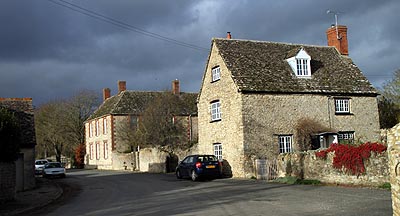 |
 |
|||
|
|
Shellingford was the ‘ford of the Scaringas,’ a Saxon sub-tribe who lived in the area. It appears in a Saxon Charter of AD 931 when Abingdon Abbey was given twelve hides of land there by the King. The Abbey owned both manors, Shellingford Newbury and Shellingford Blewbury, where they maintained granges under local reeves. They supplied fish, chickens, eggs and dairy produce to the kitchener and the refectory. Malting and milling were major industries amongst the villagers in the past. A mill is recorded as early as 1085 and the parish registers record how Florence Cowley was “killed by ye old mill wheel by a mischance” in 1589. Shellingford Blewbury was named after the family of that name who owned the manor. A younger son of the Blewburys became Rector of Shellingford and is buried beneath a marble monument in the 12th century church dated 1372. Unfortunately its fine brass was removed long ago. Shellingford stood on the Saltway from Droitwich to Southampton and a 'Salt Market' was held in the village from Saxon times until well into the 13th century. The Abbot of Abingdon also held an annual fair at Shellingford but, in 1212, a dispute arose with the Lord of the Manor of Wantage where a fair was held on the same day, St. Faith’s Day 6th October. The Abbot was forced to abandon the Shellingford Fair but, within nine years, he had obtained permission to hold it on the day before instead. This only lasted for three years however and, in 1224, it was agreed that only the Wantage Fair would continue. Despite this, it seems the people of Shellingford continued to meet on the allotted day for at least the next fifty years. Fulk FitzWarin, the lord of Wantage who let his cousin Sir Ivo live at the manor, eventually got very angry and had his men drive the traders all the way from Shellingford to his own fair. There was something of a scuffle and a man named Seman was killed. Holywell House is a fine stone building dating back to at least the late 15th century. It has excellent plasterwork ceilings dating from the time of the Wars of the Roses. They show birds and plants and the white rose ‘en-soleil’ of King Edward IV, so the house must have been owned by a prominent Yorkist. Shellingford House is the old rectory, built in the 16th century. It is haunted by a ghostly bearded parson. The previous rectory was briefly the home of John Morton, eventually Archbishop of Canterbury. An old door leading into the garden at Quarry House may have come from the old manor. Shellingford Manor, locally known as ‘Shellingford Castle,’ was a beautiful Tudor mansion built next to the church by the Untons of Wadley House in Faringdon. Both the Untons and, in the following century, the Nevilles of Billingbear Park in Waltham St. Lawrence used it as a dower house. The widow of the famous Ambassador to France, Sir Henry Neville, retired to Shellingford and died there in 1632. Afterwards, Sir Henry’s secretary, John Packer, took up residence, having purchased the house some twelve years earlier. The Packers became the heirs to the Winchcombes of Bucklebury House and eventually moved away. The manor was left to decay and was finally pulled down in the 19th century. The present great country house of the parish is Kitemore House. It was built in 1867 for the blind lord of the manor, Thomas Mills Goodlake, coincidentally also of Wadley House in Faringdon. It is said that he didn’t live there for long, however, because he could not stand the sound of the wind in the chimneys. The house was extended in 1905 and altered again in 1928. From 1906 it was the home of Col. Harold Greenwood Henderson MP & JP, both son and father of two Lords Faringdon.
|
|||
| © Nash Ford Publishing 2008. All Rights Reserved. This location is now administered by Oxfordshire County Council. | ||||



 Shellingford
Shellingford